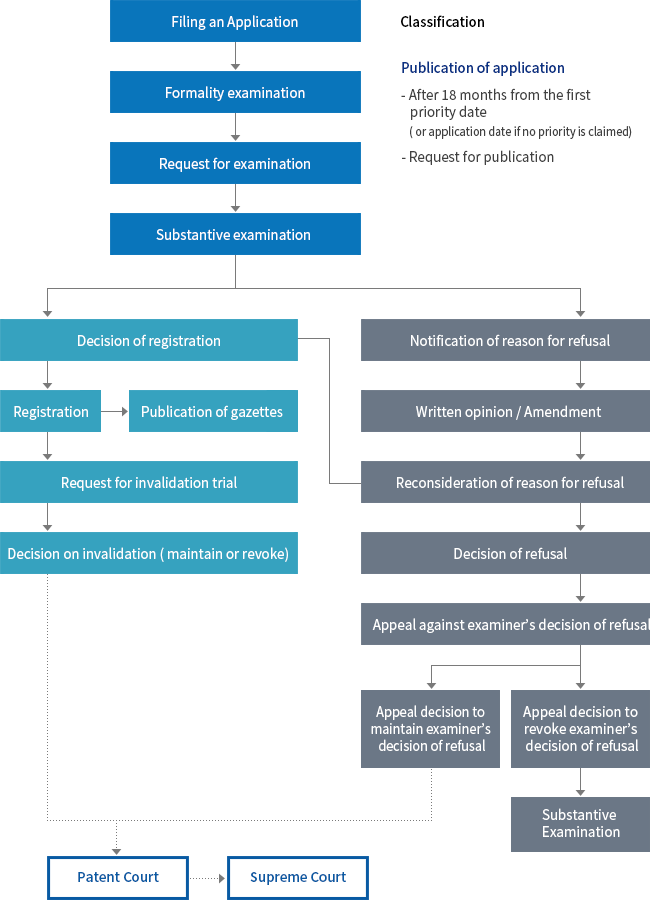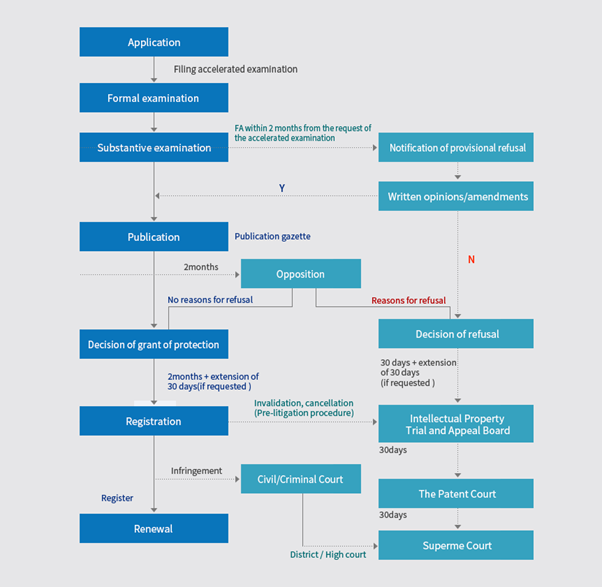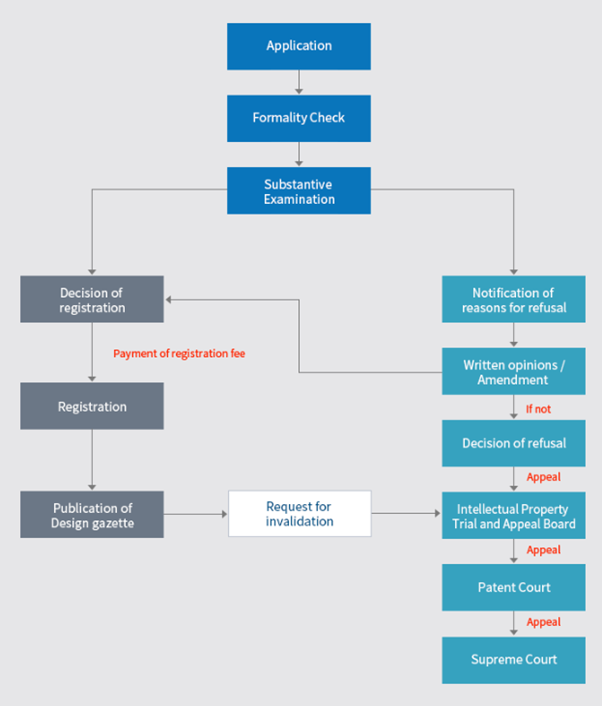NOBEL
Korean IP Overview
Your Trusted Partner in Innovation.
1.1. Patent Invalidation System
Korea does not have a formal post-grant opposition system like the European
Patent Office (EPO).
Instead, a Patent Invalidation Trial can be filed with the Intellectual Property
Trial and Appeal
Board (IPTAB) to challenge the validity of a granted patent.
The trial process resembles litigation and requires substantial documentary evidence and expert
opinions.
Unlike some jurisdictions where an entire patent may be revoked, Korea allows partial
invalidation, meaning only specific claims may be nullified while the rest remain
valid.
The decision of the IPTAB can be appealed to the Patent Court of Korea and ultimately to the
Supreme Court of Korea, making the process complex and highly strategic.
1.2. Grace Period for Prior Disclosure
Korea provides a 12-month grace period for prior disclosures made by the
inventor, similar to the United States (AIA system) and Japan.
This grace period allows an applicant to file a patent application within 12 months after
public disclosure without losing novelty.
However, unlike the USPTO, KIPO requires applicants to submit proof of
disclosure along with the application to benefit from this grace period.
The grace period is not as broad as in the U.S. and differs from the EPO, where very limited
exceptions apply for prior disclosures.
This feature offers flexibility for inventors who may have unintentionally disclosed their
invention before filing.
1.3. Divisional Application and Patent Linkage System
Korea allows applicants to file divisional applications before the final
decision is made, similar to the USPTO and JPO.
However, due to strict claim fees, applicants must strategically
manage their claim structure to avoid excessive costs.
Additionally, Korea has a Patent Linkage System for Pharmaceuticals, similar to
the Hatch-Waxman Act in the U.S.: Generic drug manufacturers must notify the original patent
holder before launching their product.
The original patent holder can request a nine-month stay to initiate legal action. This system
ensures stronger patent enforcement in the pharmaceutical and biotech industries, making Korea one
of the few jurisdictions with a formal patent linkage framework.
1.4. Korean Utility Model System
Unlike the USPTO, which does not offer utility model protection, Korea provides a Utility
Model Registration System for inventions with lower inventive steps but
practical
applicability.
The protection term is 10 years, shorter than the 20-year patent term. Unlike China and Germany,
where utility models are granted without substantive examination, Korea requires a certain level
of examination, making the process more rigorous.
Invalidation rates for utility models are relatively high, so applicants must carefully assess
prior art before filing.
This system serves as an alternative protection route for minor but commercially valuable
innovations.
2.1. Strict Inventive Step (Non-Obviousness) Standard
KIPO applies a higher standard for inventive step (non-obviousness)than some
jurisdictions.
Examiners require a clear technical contribution beyond a mere combination of prior
art.
Simply combining known elements or making predictable modifications is often insufficient to meet
the inventive step requirement. Compared to the USPTO, which applies the Graham factors in
assessing non-obviousness, KIPO tends to set a stricter threshold, requiring applicants to
demonstrate unexpected technical effects or significant improvements.
This makes patent prosecution in Korea more challenging, especially for incremental innovations.
2.2. Multiple Dependency Restrictions
KIPO imposes strict limitations on multiple dependent claims, unlike the
EPO and JPO, which allow
broader multiple dependency structures. In Korea, a multiple dependent claim cannot depend
on another multiple dependent claim, limiting drafting flexibility.
This rule can create compatibility issues for PCT applications, as applicants must modify claims
before entering the Korean national phase.
Failure to comply can lead to formal rejections and additional office actions.
To avoid unnecessary delays, applicants should review claim dependencies at the drafting stage.
2.3. Final Rejection and Appeal System
KIPO follows a two-round examination process, meaning that a Final
Rejection (Final Office Action) limits further prosecution options unless an appeal is
filed.
Unlike the USPTO, which allows Request for Continued Examination (RCE) to keep
prosecution open, Korea requires applicants to file an appeal with the IPTAB if
they wish to contest a final rejection.
If the IPTAB denies the appeal, applicants can escalate the case to the Patent Court of Korea and
ultimately the Supreme Court of Korea. This system requires applicants to prepare strong responses
early in prosecution, as opportunities for amendment after a final rejection are limited.
2.4. Excessive Claim Fees for Large Claim Sets
Unlike some jurisdictions where multiple claims can be filed with minimal
additional costs, Korea imposes substantial fees for excessive claims.
KIPO’s claim fee structure is significantly higher than that of the USPTO and JPO, particularly
for applications with broad claim sets.
This encourages applicants to streamline claims, focusing on essential aspects of the
invention.
To ensure broad protection without excessive costs, applicants often utilize divisional
applications or continuation strategies.
Thus, claim drafting in Korea requires a careful balance between scope and cost efficiency.
2.5. Accelerated Examination System (Korea’s PACE Program)
KIPO operates one of the fastest accelerated examination systems, allowing
patents to be granted in a shorter period compared to standard procedures.
Applicants can request expedited review based on factors such as commercial use,
litigation, or green technology classification.
Patents granted in foreign jurisdictions (e.g., USPTO, EPO, JPO) may also qualify for prioritized
examination in Korea under the Patent Prosecution Highway (PPH).
This makes Korea an attractive jurisdiction for applicants seeking rapid patent protection,
particularly in high-tech industries.
2.6. Patent Prosecution Highway (PPH) and Global Cooperation
KIPO actively participates in Patent Prosecution Highway (PPH) agreements with
major patent offices, including the USPTO, EPO, JPO, and
CNIPA.
Applicants can leverage favorable examination results from one jurisdiction to
accelerate prosecution in Korea.
However, KIPO retains full discretion over substantive examination, meaning that a foreign-granted
patent does not guarantee approval in Korea. To qualify, claims in the Korean application must be
substantially similar to those granted abroad.
PPH agreements significantly reduce examination time and costs, making Korea a strategic
jurisdiction for global patent filings.
After a patent application is filed with KIPO, a patent right is granted through various steps.
The Korean system is characterized by:
(i) First-to-File Rule;
(ii) Publication of Unexamined Application;
(iii) Request for Examination
The procedure for registering a utility model is the same as that of a patent except for some
notification periods.
Procedures for Granting a Patent and Utility Model (the Utility Model under Utility Model Act
which was entered into on October 1, 2006)

(quoted from KIPO at Click here)
4.1. Examines Both Absolute and Relative Grounds for Refusal
KIPO examines trademarks for compliance with both absolute and relative grounds for refusal.
Absolute grounds include lack of distinctiveness or descriptiveness (Trademark Act, Article 33),
while relative grounds cover conflicts with earlier-filed or registered trademarks (Trademark Act,
Articles 34 and 35).
Any trademark designating goods/services that are identical or similar to the designated goods,
which is identical or similar to an earlier-filed application or a registered trademark of another
person is subject to a rejection.
4.2. Coexistence Agreement Letter
Even if a trademark application receives a notification of refusal based on Article 35(1) or
Article 34(1)(vii) or of the Trademark Act for being identical or similar to an earlier-filed
application or a registered trademark based on an earlier-filed application (hereinafter, “the
prior registration”) in mark and goods/services, the applicant may overcome the refusal by
obtaining consent for the trademark registration and submitting a coexistence agreement letter
signed by the earlier applicant or the holder of the prior registration.
However, if the trademark and its goods/services are identical to the earlier-filed application or
the prior registration, submitting a coexistence agreement letter cannot overcome the refusal.
4.3. Strict Approach to Distinctiveness
Korean examination practice tends to be strict in recognizing distinctiveness.
Trademarks that are deemed generic, descriptive, or lacking inherent distinctiveness are likely to
face refusals under absolute grounds (Trademark Act, Article 33).
Additionally, in cases of acquired distinctiveness through use, a relatively high level of
consumer recognition is required to satisfy the criteria.
4.4. Publication and Opposition
Where an examiner fails to discover any ground for rejection against a trademark application, the
examiner publishes such application before registration.
A two-month opposition period follows publication, during which third parties may file a formal
objection (Trademark Act, Article 60).
Any person, with or without an interest, is eligible to file a formal objection.
If no formal objection is filed after the publication of the application, or if the examiner
dismisses all formal objections, the trademark will be registered.
Trademarks and service marks are protected in the Republic of Korea under the Trademark Act; and
for such protection, marks should be registered with the Korean Intellectual Property Office
(KIPO). The use of a trademark is not a prerequisite for filing an application for the
registration of a trademark. Although the Trademark Act does not protect unregistered marks, it
does provide protection of well-known or famous marks by restricting the registration of an
identical or similar mark. There is no course of action against infringement of a well-known or
famous unregistered trademark under the Trademark Act, but action may be pursued under the Unfair
Competition Prevention Act.
The Korean Trademark Law is characterized by :
i) First-to-File Rule;
ii) Substantive Examination;
iii) Opposition

(quoted from KIPO at Click here)
6.1. Substantive Examination for Registered Designs
Unlike some jurisdictions that allow design registrations without substantive examination (e.g.,
the EUIPO’s Registered Community Designs), Korea requires substantive examination for most design
applications.
KIPO assesses novelty, creativity, and industrial applicability before granting registration.
This examination process ensures higher validity and enforceability of registered designs.
However, this also means a longer registration process compared to non-examined design systems.
6.2. Partial Design Protection
Korea allows for partial design protection, meaning that applicants can claim rights over a
specific part of a product’s design rather than the entire design.
This is particularly useful
for high-tech industries, fashion, and consumer products where individual components hold
significant design value.
Partial designs are examined under similar standards as full designs but provide flexibility in
scope.
This system is more comprehensive than the U.S. design patent system, which typically protects the
entire ornamental appearance rather than specific portions.
6.3. Related Design System
Korea offers a Related Design System, which allows applicants to file additional design
variations based on an original design application. These related designs must be similar but not
identical to the original design.
The system provides flexibility for product lines with minor design modifications.
This is particularly beneficial in industries such as electronics, automotive, and fashion, where
designs evolve incrementally.
This feature is distinct from the EU design system, which primarily supports multiple design
filings but lacks a structured related design mechanism.
6.4. Protection for GUI (Graphical User Interfaces)
Korea provides explicit protection for Graphical User Interfaces (GUIs) as design rights, unlike
some jurisdictions where GUIs may only be protected under copyright or trademark law.
GUI protection covers icons, screen layouts, and interactive designs.
It is particularly relevant for software, fintech, and mobile applications.
Applicants can claim GUI designs independently or as part of a physical device.
This makes Korea an attractive jurisdiction for digital interface protection, aligning with Japan
and China, which also provide strong GUI protections.
6.5. Non-Examination System for Short-Term Designs
Korea allows for a non-examined design registration system for certain products with short market
lifespans (e.g., fashion items, accessories).
These designs are registered faster than standard examined designs.
However, they have a shorter protection term and are subject to post-grant invalidation
proceedings.
This is similar to the EUIPO’s unregistered Community design protection, but Korea still grants
formal registration, making enforcement easier.
6.6. Design Rights Term and Renewal System
The term of design protection in Korea is 25 years from the filing date, which is longer than
some older design systems but now aligns with global standards (e.g., EU, Japan, and China).
Unlike trademarks, design rights are non-renewable, meaning that once the 25-year term expires,
the design enters the public domain.
Currently, the Design Protection System in the Republic of Korea is in transition from a Substantive Examination System (SES) to a Partial-Substantive Examination System (PSES). In response to the request of applicants to expedite the procedure for the registration of designs, KIPO revised the Act and introduced the PSES for some short-term life-cycle products as of March 1, 1998.
Under the PSES, applicants may be granted registration within 1 or 2 months from the filing date, as well as enjoy new procedures such as Multiple Application and Post-Grant Opposition for their convenience.
Even though the applications under the PSES are not examined substantially, the effects of rights under the PSES are identical with those under the SES. Nevertheless, the registered rights under the PSES which do not fulfill the requirements will be cancelled or invalidated through the Post-Grant Opposition or Trial.

(quoted from KIPO at Click here)
